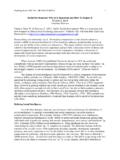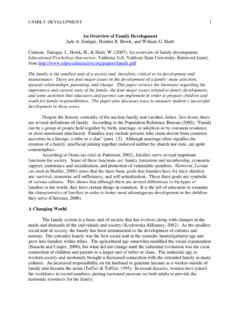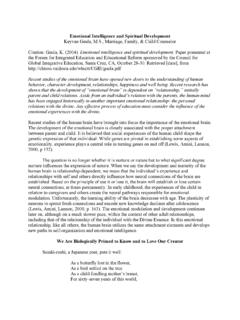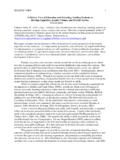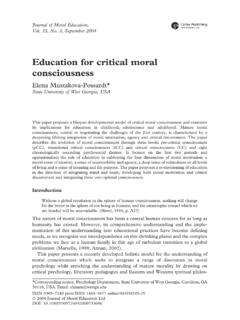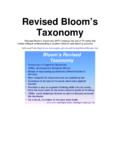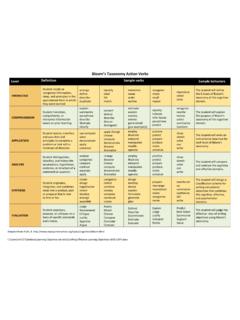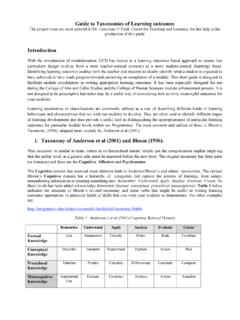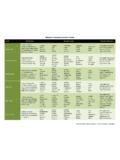Transcription of Bloom et al.'s Taxonomy of the Cognitive Domain
1 Bloom et al.'s Taxonomy of the Cognitive Domain Citation: Huitt, W. (2011). Bloom et al.'s Taxonomy of the Cognitive Domain . educational Psychology Interactive. Valdosta, GA: Valdosta State University. Retrieved [date], from [pdf] Return to | Overview of the Cognitive System | EdPsyc Interactive: Courses | Beginning in 1948, a group of educators undertook the task of classifying education goals and objectives. The intent was to develop a classification system for three domains: the Cognitive , the affective, and the psychomotor. Work on the Cognitive Domain was completed in the 1950s and is commonly referred to as Bloom 's Taxonomy of the Cognitive Domain ( Bloom , Englehart, Furst, Hill, & Krathwohl, 1956).
2 Others have developed taxonomies for the affective and psychomotor domains. The major idea of the Taxonomy is that what educators want students to know (encompassed in statements of educational objectives) can be arranged in a hierarchy from less to more complex. The levels are understood to be successive, so that one level must be mastered before the next level can be reached. The original levels by Bloom et al. (1956) were ordered as follows: Knowledge, Comprehension, Application, Analysis, Synthesis, and Evaluation. The Taxonomy is presented below with sample verbs and a sample behavior statement for each level. LEVEL DEFINITION SAMPLE VERBS SAMPLE BEHAVIORS KNOWLEDGE Student recalls or recognizes information, ideas, and principles in the approximate form in which they were learned.
3 Write List Label Name State Define The student will define the 6 levels of Bloom 's Taxonomy of the Cognitive Domain . COMPREHENSION Student translates, comprehends, or interprets information based on prior learning. Explain Summarize Paraphrase Describe Illustrate The student will explain the purpose of Bloom 's Taxonomy of the Cognitive Domain . APPLICATION Student selects, trans- fers, and uses data and principles to complete a problem or task with a mini- mum of direction. Use Compute Solve Demonstrate Apply Construct The student will write an instructional objective for each level of Bloom 's Taxonomy . ANALYSIS Student distinguishes, classifies, and relates the assumptions, hypotheses, evidence, or structure of a statement or question.
4 Analyze Categorize Compare Contrast Separate The student will compare and contrast the Cognitive and affective domains. SYNTHESIS Student originates, integrates, and combines ideas into a product, plan or proposal that is new to him or her. Create Design Hypothesize Invent Develop The student will design a classification scheme for writing educational objectives that combines the Cognitive , affective, and psychomotor domains. EVALUATION Student appraises, assesses, or critiques on a basis of specific standards and criteria. Judge Recommend Critique Justify The student will judge the effective- ness of writing objectives using Bloom 's Taxonomy . Anderson and Krathwohl (2001) revised Bloom 's Taxonomy to fit the more outcome-focused modern education objectives, including switching the names of the levels from nouns to active verbs, and reversing the order of the highest two levels (see Krathwohl, 2002 for an overview).
5 The lowest-order level (Knowledge) becameRemembering, in which the student is asked to recall or remember information. Comprehension, became Understanding, in which the student would explain or describe concepts. Application became Applying, or using the information in some new way, such as choosing, writing, or interpreting. Analysis was revised to become Analyzing, requiring the student to differentiate between different components or relationships, demonstrating the ability to compare and contrast. These four levels remain the same as Bloom et al. s (1956) original hierarchy. In general, research over the last 40 years has confirmed these levels as a hierarchy (Anderson & Krathwohl).
6 In addition to revising the Taxonomy , Anderson and Krathwohl added a conceptualization of knowledge dimensions within which these processing levels are used (factual, conceptual, procedural, and metacognition). The Center for Excellence in Learning and Teaching at Iowa State University (2011) provides an excellent graphic representation on how these two taxonomies can be used together to generate lesson objectives. The two highest, most complex levels of Synthesis and Evaluation were reversed in the revised model, and were renamed Evaluating and Creating (Anderson & Krathwohl, 2001). As they did not provide empirical evidence for this reversal, it is my belief that these two highest levels are essentially equal in level of complexity.
7 Both depend on analysis as a foundational process. However, synthesis or creating requires rearranging the parts in a new, original way whereas evaluation or evaluating requires a comparison to a standard with a judgment as to good, better or best. This is similar to the distinction between creative thinking and critical thinking. Both are valuable while neither is superior. In fact, when either is omitted during the problem solving process, effectiveness declines (Huitt, 1992). Synthesis Evaluation Analysis Application Comprehension Knowledge In any case it is clear that students can "know" about a topic or subject at different levels. While most teacher-made tests still test at the lower levels of the Taxonomy , research has shown that students remember more when they have learned to handle the topic at the higher levels of the Taxonomy (Garavalia, Hummel, Wiley, & Huitt, 1999).
8 This is because more elaboration is required, a principle of learning based on finding from the information processing approach to learning. Krathwohl, Bloom , and Masia (1956) also developed a Taxonomy for the affective Domain . In my opinion, this Taxonomy is really more of a reflection of attachment or valuing rather than processing affective-related information as reflected in the Cognitive Taxonomy . There are three taxonomies of the psychomotor Domain that are received acceptance (Dave, 1975; Harrow, 1972; Simpson, 1972). Clark (2010) provides an overview of these three taxonomies. References Anderson, , & Krathwohl (Eds.). (2001). A Taxonomy for Learning, Teaching, and Assessing: A Revision of Bloom 's Taxonomy of educational Objectives.
9 New York: Longman. Bloom , B., Englehart, M. Furst, E., Hill, W., & Krathwohl, D. (1956). Taxonomy of educational objectives: The classification of educational goals. Handbook I: Cognitive Domain . New York, Toronto: Longmans, Green. Center for Excellence in Learning and Teaching (CELT). (2011). A model of learning objectives. Iowa State University. Retrieved March 2011, Clark, D. (2010). Bloom 's Taxonomy of learning domains: The three types of learning. Big Dog & Little Dog's Performance Juxtaposition. Edmonds, WA: Author. Retrieved from ~donclark/ Dave, R. H. (1970). Psychomotor levels. In R. J. Armstrong (Ed.), Developing and writing behavioral objectives. Tucson, Arizona: educational Innovators Press.
10 Forehand, M. (2005). Bloom 's Taxonomy : Original and In M. Orey (Ed.), Emerging perspectives on learning, teaching, and technology. Retrieved January 2009, from Garavalia, L., Hummel, J., Wiley, L., & Huitt, W. (1999). Constructing the course syllabus: Faculty and student perceptions of important syllabus of Excellence in College Teaching, 10(1), 5-22. Available online at Harrow, A. (1972). A Taxonomy of the psychomotor Domain : A guide for developing behavioral objectives. New York: David McKay. Huitt, W. (1992). Problem solving and decision making: Consideration of individual differences using the Myers-Briggs Type Indicator. Journal of Psychological Type, 24, 33-44. Retrieved June 2004, from Krathwohl, D.
